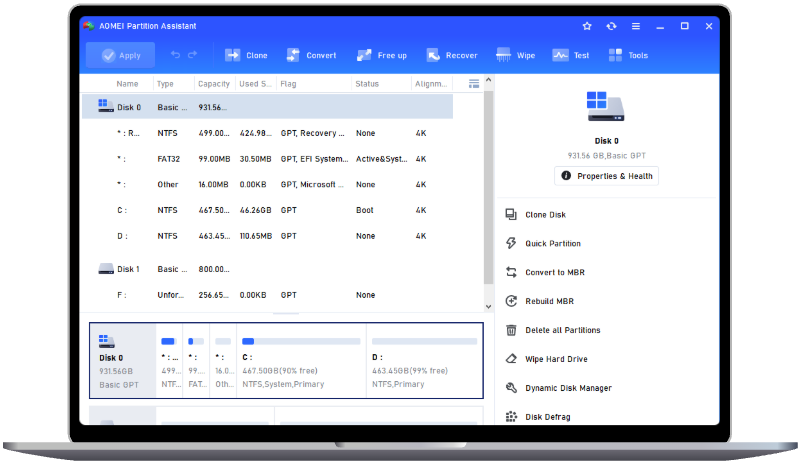External Hard Drive Taking Too Long to Format? Fix It Now!
Is your external hard drive taking too long to format? No worries! In this article, we explore the reasons behind slow formatting and provide several methods to fix the issue. Don’t let slow formatting slow you down—learn how to resolve the issue now!
How Long Does It Take to Format a Hard Drive?
Formatting a hard drive is a crucial step in preparing it for use, whether you’re setting up a new drive or troubleshooting issues with an existing one. However, the time it takes to format a hard drive can vary widely depending on several factors, including:
Connection Type: USB 2.0 connections are slower than USB 3.0 or USB-C.
Format Type: A quick format takes only a few minutes, while a full format can take hours, as it checks for bad sectors and erases all data.
Drive Size: Larger drives take longer to format. For example, a 1TB drive will take more time than a 500GB drive.
Drive Health: A drive with bad sectors or hardware issues may take longer to format.
How to Fix an External Hard Drive Taking Too Long to Format?
If your external hard drive is taking too long to format, don’t panic. Here are five effective fixes to resolve the issue:
Fix 1. Check the Connection
A poor or unstable connection can significantly slow down the formatting process. Before proceeding with other fixes, ensure your external hard drive is properly connected.
Go to check for any visible damage to the USB cable first. If the cable is frayed or bent, replace it with a new one. If the issue persists, connect the drive to another computer to rule out port or system-related problems. For optimal performance, use a USB 3.0 or USB-C port, as these offer faster data transfer speeds compared to older USB 2.0 ports.
Fix 2. Choose Quick Format Instead of Full Format
A full format scans the entire drive for errors and bad sectors, which can take hours. If you don’t need a thorough scan, choose the quick format to format your drive.
Step 1: Press Win + R, type diskmgmt.msc, and press Enter to open Disk Management.
Step 2: Right-click on the external hard drive to format and click on “Format…” in the drop-down menu.
Step 3: In the Format window, select a file system and then tick “Perform a quick format”.
Step 4: Click “OK” to start the process.
Fix 3. Delete the Old Partition and Create a New One
If your external hard drive is still taking too long to format even after performing a quick format, the issue might be caused by corrupted partitions. Fortunately, you can resolve this by deleting the old partition and creating a new one. AOMEI Partition Assistant is a reliable and professional tool designed for efficient disk management. This versatile software allows you to easily create, delete, merge, format, or resize partitions as needed. Feel free to download it and give it a try!
- Fully compatible with Windows 11/10/8.1/8/7 and Windows Server versions.
- Provides multiple advanced features to optimize your disk management.
- Features an intuitive interface, making it accessible for both beginners and advanced users.
Let’s use AOMEI Partition Assistant to delete old partitions and create a new one:
➤ Stage 1. Delete the Old Partitions
Step 1: Launch AOMEI Partition Assistant; right-click the drive and select “Delete Partition”.
Step 2: Choose a deletion method according to your needs, then click on “OK”. If you want to delete all partitions at once, consider using the “Delete all Partitions” feature.
Here are two options:
✔ Delete partition quickly: You can recover the data that has been deleted.
✔ Delete partition and wipe all data to prevent data recovery: Delete the partition and wipe all data on it. Typically, you cannot recover the data that has been deleted.
Step 3: Click on “Apply” to commit the pending operation.
➤ Stage 2. Create a New Partition
Now that all partitions have been removed, you can create new ones to store data.
Step 1: Right-click on the unallocated space and select “Create Partition”.
Step 2: Specify the size, file system, and drive letter of the new partition, and then click “OK” to continue. If you want to create more partitions later, you can move the dot on both sides and leave some unallocated space to create more partitions.
Step 3: Click on “Apply” on the upper left and then hit “Proceed” to start the creating process.
If you want to create multiple partitions with one click, the “Quick Partition” within AOMEI Partition Assistant is your best choice.
Fix 4. Check for Bad Sectors
Additionally, bad sectors can also slow down the formatting process. To figure it out, you can run AOMEI Partition Assistant again to check for bad sectors. Here’s how to do that:
Step 1: Right-click the partition you want to check, and then choose "Advanced"> "Check Partition".
Step 2: Here are three choices to check errors. Select the one that suits your needs and click "OK" to continue.
Step 3: Click the "Start" button to check your partition. After identifying the bad sectors on your external drive, you can isolate them by creating an independent unallocated space or utilize specialized tools to repair the damaged areas.
Fix 5. Update or Reinstall USB Drivers
Sometimes, outdated or corrupted USB drivers can cause slow formatting. Follow these steps to update or reinstall the drivers:
Step 1: Right-click "This PC", select Properties > Device Manager, and then expand "Universal Serial Bus Controllers".
Step 2: Right-click the drive and select "Properties". Then, select "Update Driver" under the "Driver" option.
Step 3: Click Search automatically for updated driver software.
Step 4: After that, restart your computer and connect the drive to see if it can be detected.
Final Words
How long to format a hard drive depends on several factors, including drive size, format type, and drive health. If your external hard drive is taking too long to format, don’t worry—this guide provides practical fixes to resolve the issue. By using the right tools and techniques, you can speed up the formatting process and ensure your external hard drive operates efficiently.
FAQs
Q1: How long does it take to format a hard drive?
A: The time depends on the drive size, format type, and drive health. A quick format takes minutes, while a full format can take hours.
Q2: Can I stop a format that’s taking too long?
A: Yes, but stopping a format midway can corrupt the drive. It’s better to identify and fix the underlying issue first.
Q3: What’s the difference between quick format and full format?
A: A quick format only erases the file system, while a full format checks for bad sectors and erases all data.


